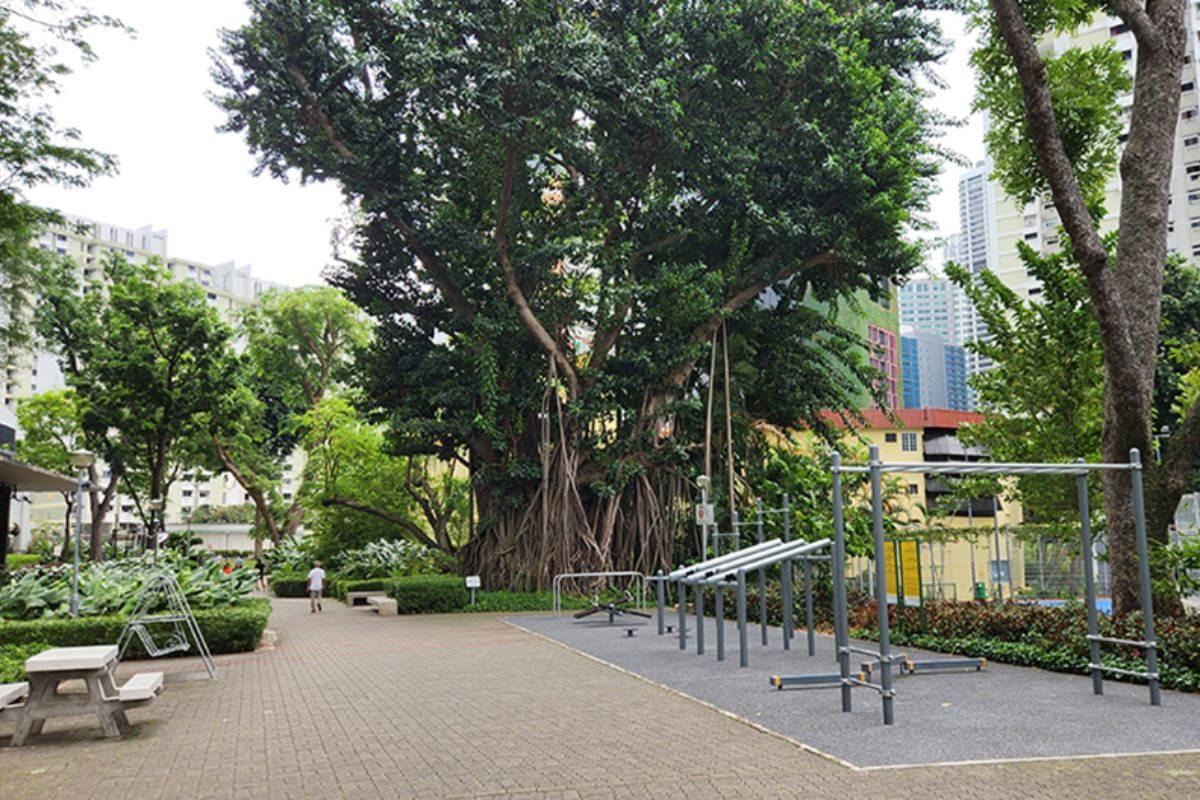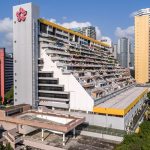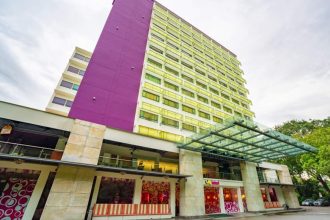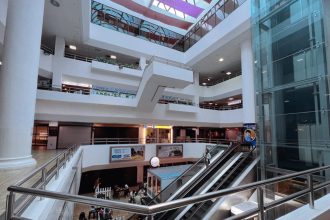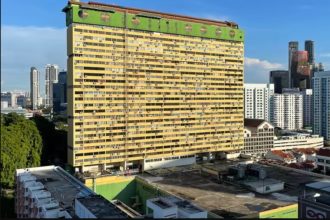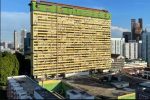Key takeaway
Duxton Plain Park is a peaceful, narrow green space in Chinatown that sits right on the route of a former 1907 railway. What was once noisy train tracks is now a calm linear park, preserving both nature and heritage. It offers shade, a historical shrine, and a nod to Singapore’s early railway past, providing a rare combination of history, culture, and greenery in the urban core.
Imagine slipping away from the hustle of New Bridge Road into a narrow ribbon of green, and realising you are walking on history. That is what Duxton Plain Park feels like. It’s more than just a park. It’s a living trace of Singapore’s early railway, now a quiet retreat in the heart of Chinatown, where each turn of the path tells a story of the city’s evolution.
Duxton Plain Park: A railway line turned green corridor
Duxton Plain Park was once part of the Singapore‑Kranji Railway. The original railway line was extended in 1907 from Tank Road down to the docks at Pasir Panjang, passing through what is today Duxton Plain. But this stretch did not last long. By around 1914, residents complained of the noise. The tracks were later dismantled, in some accounts by 1925. What remained was the shape of the route, a linear reserve that would eventually become a park. This long, thin strip is what makes the park unique compared to conventional parks in Singapore, giving it a distinct sense of direction and intimacy.
From Parkway to park: how it evolved
The idea to convert the disused railway into a park dates back to the 1950s. Plans for a linear park were announced in 1955. It opened to the public in May 1961, under the name “Duxton Plain Park.”
Today, the park is managed by NParks and spans roughly 1.8 hectares. It stretches between New Bridge Road and Yan Kit Road, with access points along Neil Road, Kreta Ayer Road, and Yan Kit Road. Over the decades, subtle renovations have enhanced its walkways, seating, and landscaping while preserving the essence of its historic railway alignment.
Walking in the footsteps of the railway
As you stroll through the park, you are literally walking over where the railroad used to run. The shape of the park echoes the curve and path of the old rails. Near Neil Road, there’s a small underpass, a reminder of how the route once bridged over the rail bed. Each curve and bend evokes the original engineering choices and the challenges of early railway construction in an urban area.
Natural touches and heritage trees
The park is planted with heritage trees. For example, there is a mature bodhi tree that towers along Neil Road. Near Yan Kit Road, you can spot a large Indian rubber tree with its thick trunk and aerial roots. Seasonal blooms and native plantings add another layer of interest throughout the year, making the park an oasis for urban biodiversity.
Adjacent to the park is Chinatown shopping atrium, one of the earliest mixed-use developments in the area. The juxtaposition of green space and bustling retail adds to the park’s charm, creating a unique urban experience.
A memorial and sundial
One striking feature is a tembusu tree planted as a memorial to Lee Kuan Yew, Singapore’s founding Prime Minister. Near that tree is a plaque, set in a design that resembles flower petals. Elsewhere in the park, there is a sundial. It comes with a small information board that explains how sundials work, and it even gives you tips on how to make one yourself. This blending of natural elements with educational tools encourages visitors to engage actively with the park.
Spiritual heritage: The Sharifah Rogayah Keramat
Tucked behind a row of shophouses, the park is home to a keramat, a shrine for Sharifah Rogayah. Legend says she was the granddaughter of Habib Noh, a well-known 19th‑century saint in Singapore. The story goes that her family denied she was buried there, but local lore claims otherwise. A young caretaker called Ahmad Ridhwan has looked after the keramat since the late 1990s, after allegedly receiving a dream about Sharifah Rogayah from Habib Noh. Visitors often leave tokens and flowers, giving the shrine a quiet spiritual presence in the urban landscape.
A living space for the community
More than history, the park is very much alive. The Chin Woo Athletic Association uses part of the park for martial arts training and traditional lion dance rehearsals. That connection to local culture has been around for decades. Community groups such as Discover Tanjong Pagar (DTP) have also adopted the park. They run tree‑planting and green‑space activation efforts, adding vibrancy and keeping the park connected to residents.
Nearby, visitors can enjoy the largest hawker centre for an authentic taste of Chinatown life. This is a short walk from the park and highlights the interplay between heritage, culture, and community space.
Duxton Plain Park: Architectural and design highlights
The park’s layout emphasizes a long, narrow strip with walking paths parallel to the former railway alignment. Benches are positioned to provide shaded resting spots, and subtle lighting ensures safe evening walks. Sculptural elements, like modern stone seating, blend with traditional landscaping, reflecting a careful balance between past and present. The use of local materials and low-impact landscaping techniques shows NParks’ commitment to sustainability and historical integrity.
Engaging activities and events
Duxton Plain Park hosts seasonal cultural activities, from small-scale heritage tours to outdoor tai chi sessions. School groups sometimes visit to learn about Singapore’s early railway history, while local artists use the park as an open-air gallery for exhibitions. This combination of learning, leisure, and exercise makes the park a versatile public space suitable for all ages.
How Duxton Plain Park preserves the railway memory
- The linear shape of the park mirrors the original railway alignment.
- Infrastructure remnants like underpasses recall how tracks crossed under or over roads.
- Heritage trees and the sundial give the space character and continuity with its past.
- The keramat preserves social and spiritual memory from earlier generations.
- Community use by local clubs keeps the space meaningful and rooted in present-day life.
Quick facts about Duxton Plain Park
- Size: ~1.8 hectares
- Opened to the public: May 1961
- Heritage trees: Bodhi tree, Indian rubber tree
- Shrine: Sharifah Rogayah keramat
- Nearest MRT: Maxwell, Outram Park
- Managed by: National Parks Board
Duxton Plain Park in context
| Site | Key facts | Nearest MRT | Sources |
|---|---|---|---|
| Pinnacle@Duxton | 50-storey public housing, completed in 2009, is a landmark in the Tanjong Pagar skyline | Outram Park | Wikipedia |
| Eng Aun Tong (Tiger Balm) building | Former Tiger Balm factory, conserved building along Neil Road | Outram Park / Maxwell | Wikipedia |
| People’s Park railway station (former) | Station on the old Singapore‑Kranji line (1908–1930s) | Outram Park / Maxwell | Wikipedia |
Connecting the past with today
Duxton Plain Park is a reminder that urban green spaces can serve multiple roles: preserving history, providing recreation, and supporting community activities. Walking here is like moving through time, between old tracks, heritage trees, and bustling Chinatown streets. Even casual visitors notice the park’s gentle slopes, shaded benches, and thoughtful landscaping.
A walk through time and tracks
Crossing Duxton Plain Park connects you with Singapore’s early railway history, even as you enjoy a quiet piece of green in Chinatown. Visitors can also appreciate the careful preservation of heritage trees in Singapore as part of the park experience. It shows how a former transport artery can transform into a communal space without losing its story. For anyone curious about Singapore’s layered past, this park is a living, breathing testament, a green ribbon that threads history into the city.
